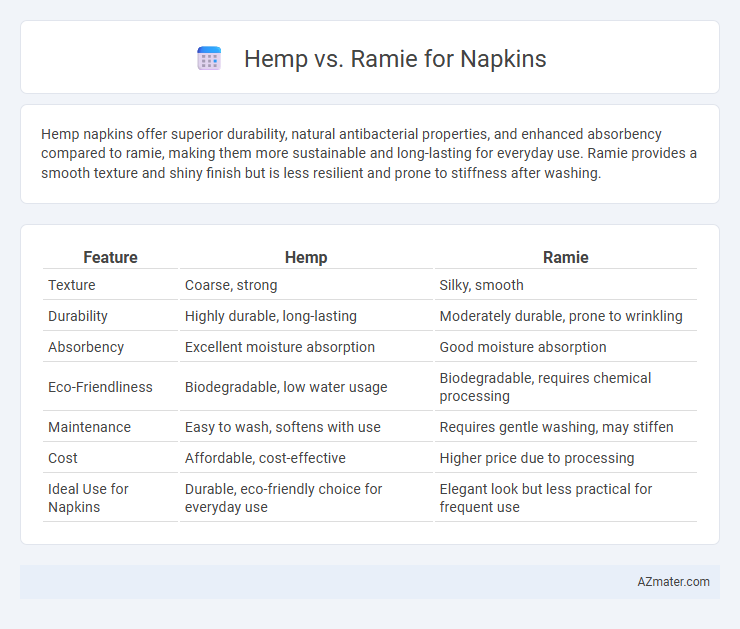Hemp napkins offer superior durability, natural antibacterial properties, and enhanced absorbency compared to ramie, making them more sustainable and long-lasting for everyday use. Ramie provides a smooth texture and shiny finish but is less resilient and prone to stiffness after washing.
Table of Comparison
| Feature | Hemp | Ramie |
|---|---|---|
| Texture | Coarse, strong | Silky, smooth |
| Durability | Highly durable, long-lasting | Moderately durable, prone to wrinkling |
| Absorbency | Excellent moisture absorption | Good moisture absorption |
| Eco-Friendliness | Biodegradable, low water usage | Biodegradable, requires chemical processing |
| Maintenance | Easy to wash, softens with use | Requires gentle washing, may stiffen |
| Cost | Affordable, cost-effective | Higher price due to processing |
| Ideal Use for Napkins | Durable, eco-friendly choice for everyday use | Elegant look but less practical for frequent use |
Introduction to Hemp and Ramie Fibers
Hemp and ramie fibers are both natural plant-based materials known for their durability and sustainability in textile production. Hemp fibers, derived from the Cannabis sativa plant, are strong, resistant to wear, and naturally antibacterial, making them ideal for napkins that require frequent washing and long-term use. Ramie, obtained from the stalks of the Chinese nettle plant, offers a silky texture and exceptional moisture-wicking properties, contributing to a soft yet sturdy fabric suitable for absorbent, eco-friendly napkins.
Historical Use of Hemp and Ramie in Textiles
Hemp has been cultivated for over 10,000 years, historically valued for its durability and moisture resistance, making it a preferred material for textiles such as napkins and other household fabrics. Ramie, known as one of the oldest fiber crops originating from East Asia, was traditionally used in fabric production for its silky luster and strength, often blending with other fibers for enhanced textile quality. Both hemp and ramie have centuries-long legacies in textile manufacturing, with hemp favored for robust, coarse fabrics and ramie prized for fine, lightweight cloths.
Cultivation and Sustainability Comparison
Hemp cultivation requires minimal pesticides and thrives in diverse climates with rapid growth cycles, making it highly sustainable, whereas ramie demands more intensive processing and frequent fertilization. Hemp fibers are extracted through water retting or decortication, which are environmentally friendly compared to ramie's energy-intensive degumming process. The lower water usage and carbon footprint of hemp contribute to its superior sustainability profile for eco-friendly napkin production.
Fiber Characteristics and Texture Differences
Hemp fibers are coarse, strong, and highly durable, lending napkins a rougher texture that softens with use and washing, making them ideal for heavy-duty, long-lasting applications. Ramie fibers are also strong but finer and smoother, producing napkins with a silky, lustrous finish and a crisp texture, which offers a more refined, luxurious feel compared to hemp. The higher absorbency and breathability of hemp contrast with ramie's resistance to wrinkling and shrinkage, influencing their suitability based on desired napkin performance and tactile quality.
Absorbency and Performance in Napkin Use
Hemp fibers exhibit superior absorbency compared to ramie, making hemp napkins more effective for quickly soaking up spills and moisture. Ramie, while less absorbent, offers exceptional strength and durability, enhancing the napkin's longevity through multiple washes. The combination of hemp's moisture retention and ramie's resilience results in high-performance napkins optimized for both absorbency and durability.
Durability and Longevity of Hemp vs Ramie Napkins
Hemp napkins demonstrate superior durability and longevity compared to ramie, thanks to their strong, fibrous structure that resists wear and tear over extended use. Ramie napkins, while smooth and lustrous, tend to degrade faster under frequent washing and heavy use due to their less flexible fibers. Consequently, hemp napkins offer a more resilient and long-lasting option for sustainable, everyday table linens.
Environmental Impact: Processing and Biodegradability
Hemp requires less water and fewer pesticides compared to ramie, making its cultivation more environmentally sustainable. The processing of hemp fibers is typically less chemically intensive, resulting in lower pollution and energy consumption. Both hemp and ramie are biodegradable, but hemp's natural resistance to pests reduces the need for chemical treatments, enhancing its overall eco-friendly profile for napkin production.
Aesthetic Appeal and Design Versatility
Hemp fabric offers a natural, rustic aesthetic with a coarse texture that enhances eco-friendly napkin designs, while ramie provides a smoother, silkier finish ideal for elegant and refined table settings. Ramie's ability to hold dyes vividly allows for diverse color palettes, making it superior for intricate patterns and sophisticated visuals. Hemp's durability combines with its organic look to create a versatile, earthy appeal that suits casual and rustic themes.
Cost and Market Availability
Hemp fibers are generally more expensive than ramie due to higher cultivation and processing costs, although hemp offers superior durability and eco-friendliness desired in premium napkin markets. Ramie, being more affordable and widely available in Asian markets, provides a cost-effective alternative with good absorbency but less softness compared to hemp. The global availability of ramie is more consistent year-round, whereas hemp supply can be limited by regulatory restrictions and seasonal production cycles.
Conclusion: Choosing the Best Fiber for Eco-Friendly Napkins
Hemp outperforms ramie in durability, absorbency, and eco-friendliness, making it the preferred fiber for sustainable napkins. Hemp's rapid growth with minimal pesticides reduces environmental impact, while its natural antimicrobial properties enhance napkin hygiene. Ramie, although strong and silky, requires more resource-intensive processing, positioning hemp as the optimal choice for eco-conscious consumers seeking high-performance napkins.

Infographic: Hemp vs Ramie for Napkin
 azmater.com
azmater.com